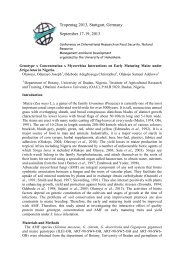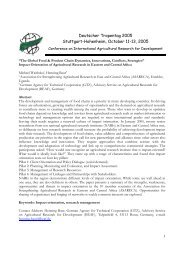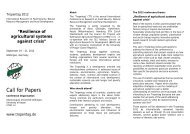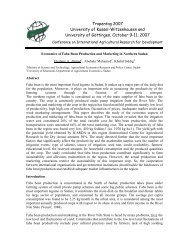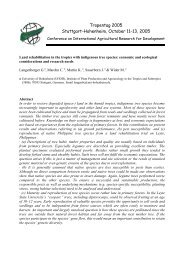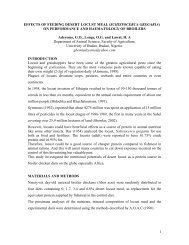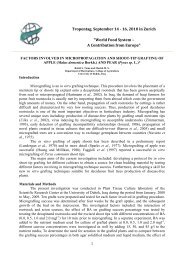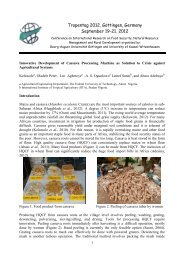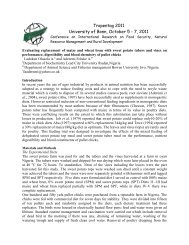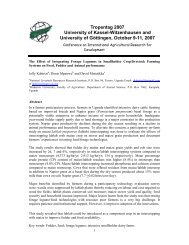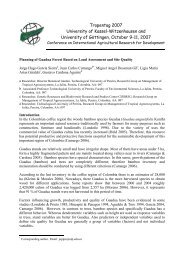Design and Construction of A Solar Dryer for Mango ... - Tropentag
Design and Construction of A Solar Dryer for Mango ... - Tropentag
Design and Construction of A Solar Dryer for Mango ... - Tropentag
Create successful ePaper yourself
Turn your PDF publications into a flip-book with our unique Google optimized e-Paper software.
From the total useful heat energy required to evaporate moisture <strong>and</strong> the net radiation received by<br />
the tilted collector, the solar drying system collector area Ac, in m 2 can be calculated from the<br />
following equation:<br />
AcIη = E = m` (hf -hi)td<br />
There<strong>for</strong>e, area <strong>of</strong> the solar collector is:<br />
(10)<br />
Ac = E/Iη (11)<br />
Where E is th total useful energy received by the drying air, kJ; I is the total global radiation on<br />
the horizontal surface during the drying period., kJ/ m 2 <strong>and</strong> η is the collector efficiency, 30 to<br />
50% (Sodha et al., 1987).<br />
Volumetric airflow rate, Va was obtained by dividing ma by density <strong>of</strong> air which is 1.2 kg/m 3<br />
v-Air vent dimentions:<br />
The air vent was calculated by dividing the volumetric airflow rate by wind speed:<br />
Av = Va/Vw (12)<br />
Where Av is the area <strong>of</strong> the air vent, m 2 , Vw wind speed, m/s.The length <strong>of</strong> air vent , Lv, m, will<br />
be equal to the length <strong>of</strong> the dryer. The width <strong>of</strong> the air vent can be given by:<br />
Bv = Av/Lv (13)<br />
Where Bv is the width <strong>of</strong> air vent, m<br />
vi-Required pressure:<br />
Velocity = Va/A<br />
Va = volumeteric flow rate m 3 /sec.<br />
The pressure difference across the mango slices bed will be solely due to the density difference<br />
between the hot air inside the dryer <strong>and</strong> the ambient air. Air pressure can be determined by<br />
equation given by Jindal <strong>and</strong> Gunasekaran (1982):<br />
P = 0.00308 g(Ti- Tam)H (14)<br />
Where: H is the pressure head (height <strong>of</strong> the hot air column from the base <strong>of</strong> the dryer to the point<br />
<strong>of</strong> air discharge from the dryer), m; P is the air pressure, Pa; g is the acceleration due gravity,<br />
9.81m/s 2 ; Tam is the ambient temperature, C.<br />
The prototype solar dryer was sized to have a minimum area <strong>of</strong> 1m 2 to be used in experimental<br />
drying tests.<br />
Table 1. <strong>Design</strong> conditions <strong>and</strong> assumptions<br />
Items Condition or assumption<br />
Location Khartoum (latitude 15º N)<br />
Crop <strong>Mango</strong><br />
Variety Kitchener<br />
Drying period April to June<br />
Drying per batch ( 2days / batch), 100kg sliced mango (195.2kg fresh<br />
loading rate (mp)<br />
mango)<br />
Initial moisture content (moisture content<br />
at harvest), Mi<br />
81.4 w.b.<br />
Final moisture content (moisture content<br />
<strong>for</strong> storage) , Mf<br />
10 % w.b.<br />
Ambient air temperature, Tam<br />
30ºC (Average <strong>for</strong> April)<br />
Ambinet relative humidity, RHam 15% (Average <strong>for</strong> April)<br />
Maximum allowable temperature, Tmax 70ºC<br />
Drying time(sunshine hours)td<br />
10 hours (Average <strong>for</strong> April)<br />
Incident solar radiation, I 20MJ/m 2 /day (average <strong>for</strong> past 30 years)<br />
Collector efficiency, η 30% (Ampratwum, 1998).<br />
Wind speed 2m/s<br />
Thickness <strong>of</strong> sliced mango 3mm<br />
Vertical distance between two adjacent<br />
trays<br />
15cm<br />
4



